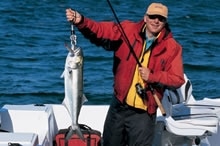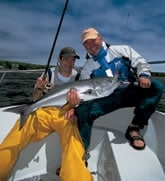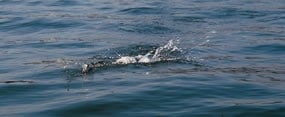
| The author hefts a good-sized blue that slammed a Cordell Pencil Popper off a Cape Cod beach last May. |
The invasion begins in May, catching many by surprise. They come from offshore and points south – lean, ravenous, mean-eyed beasts wending their way towards the spring-warmed shallows, hard on the heels of herring and squid. For months the beaches have been barren, devoid of life, nothing to greet a plug as it splashes across the surface. But you try anyway, because you know it could happen, any day now. Then comes a warm, sunny day with a summery southwest wind blowing inshore. You look seaward and catch sight of a fin poking above the surface, or perhaps a slick or a lazy swirl. You make a hopeful cast, begin the retrieve and – yes! They’re here! The big-heads are back in town!
The arrival of big-head bluefish – so-called because their outsized noggins seem so out of proportion to their snaky, winter-starved bodies – signals the official start of the season for many New England anglers. (To give proper credit, the “big-head” moniker was apparently coined by forum participants on the website www.FlyFishSaltWaters.com.) Sure, tautog, sea bass and stripers have been available since April, but the weather is still chilly and unpredictable. However, when the blues arrive in mid-May it means that inshore fishing is about to bust wide open. It also marks a return to warmer, summer-like weather patterns. Well, not always.

The May bluefish invasion is a rite of spring for many New England anglers. Here, Matt Koenig, right, shows off a snaky spring arrival taken by Tim Brockett.|
Big-Heads, Ho!
Last spring, I embarked on a big-head hunt on May 23 with Jon French, Suzuki Marine’s Northeast Regional Sales Manager; his friend Mike Picard and Boston-area photographer Eric Kulin. We launched in upper Buzzards Bay, but our destination was the stretch of coast that runs from Woods Hole to Osterville, on the south side of Cape Cod. Unfortunately, the wind was honking straight down the bay, which made for a slow, lumpy ride to Woods Hole. However, once we entered Vineyard Sound, the easterly current flattened the seas somewhat and we made good time on the run to South Cape Beach, a perennial hot spot for early-season blues.
We set up an inshore drift about 200 yards off the beach in some 15 feet of water and began launching big pencil poppers and other topwater plugs downwind. At first it seemed like we’d have to do some searching to find the fish, but then my popper suddenly disappeared in a burst of spray and I knew we had found them. My fish weighed in at ten pounds, a typical size for big-heads, and was a light, powder-blue in color – very different from the porky, olive-hued fish of late summer and fall. After a summer of fattening up in the waters of New England, this same fish would likely weigh better than 15 pounds
One thing about big-heads: once you find one, you’ve found a bunch, and this day was no exception. The four of us enjoyed almost non-stop action for about two hours along the beach before the tide started to ebb and the fish began to clam up and move out to deeper water. Until then, however, it was a fish every five casts or so. The drill was as simple as it gets: set up a drift toward the beach and cast like mad until the blues came a-chargin’. We could see fish cruising everywhere in the green water, and we caught them as close in as three feet from the beach.

Medium spinning gear loaded with 12- to 15-pound line is ideal for taking on spring blues. This one hit a homemade plug.|
Plugger’s Dream
If you don’t enjoy watching a pack of crazed fish chasing after a surface plug, this is not your game. In fact, you might consider giving up the sport of fishing altogether. For topwater aficionados, however, this is a magic time. It also happens to be one of the most reliable inshore fisheries on the Northeast coast.
As mentioned, the blues typically arrive in southern New England waters around May 15th, with the best action for the bigger fish running through the first week in June. The places to look for them include exposed, south-facing beaches, such as those along the south shore of Cape Cod, western Rhode Island, Martha’s Vineyard and up into Buzzards Bay. A southwest wind and a stretch of warm weather usually pushes the fish inshore, where they gang up to feed on schools of squid near the surface. In fact, one good indicator that the blues will soon be arriving is the presence of commercial trawlers drag-ging for squid just off the southern beaches of Cape Cod.
Weather and water temperature at this time are key, as the blues are right on the edge of their tolerance range. A cold front with northerly winds can put the fish in a funk, drive them deeper and shut down the action. The cold water also causes the fish to do strange things. On calm days you can often see the big blues lazing on the surface with dorsal and tail fins exposed, presumably taking advantage of the warmer surface waters. These fish can be quite skittish, but will hit a topwater plug that is cast well beyond them and retrieved several feet in front of their noses. Flies can be even more effective because of their limited surface disturbance. Cast them just ahead of the fish and begin a fast retrieve.

Packs of ravenous big-heads provide non-stop thrills as they pursue poppers all the way to the boat.|
Sight-Casting Action
If you have a shallow-draft boat, be sure to look for early-season blues on the sand flats in two to five feet of water.
If the sun is bright and the wind calm, you can often drift or anchor in the shallows and sight-cast to packs of blues as they cruise across the flats. Believe me, it’s pretty exciting to watch a 12-pound bluefish suddenly turn on your plug or fly, follow it and strike in aquarium-like conditions.
Lure selection is pretty basic, as it often is with blues. A variety of topwater plugs will draw strikes, but over the years I have found the Cordell Pencil Popper to be most productive, perhaps due to its internal rattle. It’s also one of the least-expensive poppers, so you won’t mind as much if you get cut off. Other favorites include the Yo-Zuri Hydro Tiger, Yo-Zuri Surface Cruiser, Atom Striper Swiper, Creek Chub Striper Strike, Ranger, Ballistic Missile and the Gibb’s Polaris. Color doesn’t seem to matter, especially with pencil poppers, but I have found that fluorescent green and orange sometime draw more strikes on overcast days.

When the action is fast and furious, rig your plugs with barbless single hooks to facilitate release.|
Many of these lures come rigged with two sets of treble hooks, which can be difficult – and dangerous – to remove from the mouth of a large, flailing blue. I like to remove all trebles from my plugs and use a single Gamakatsu 7/0 Siwash as the rear hook. This makes releasing the fish a lot easier, and reduces the risk of foul-hooking. I might lose a few more fish to thrown hooks, but the action is usually so good that it doesn’t matter.
Medium-heavy spinning gear is ideal for this game. I prefer a seven-foot rod rated for 15- to 20-pound line with a stiff tip and plenty of backbone. This rod lets me throw large poppers long distances and gives me the power to muscle a big blue to the boat in short order, so I can get back in the game. You can use lighter gear, of course, but be prepared for a long fight.
Fly fishermen will have blast with big-heads on nine- or ten-weight rods rigged with floating or intermediate line. Best flies are poppers, gurglers, sliders and large, all-white streamers and squid patterns. Strangely, the fish can be very selective about flies, and will often follow them right to the boat without striking. If this happens, try different retrieves and change flies often until you find one they like.
Unfortunately, the spring run of big blues is a short-lived phenomenon, lasting only two or three weeks. As the inshore waters warm and the squid depart, the big-heads move steadily offshore, to be replaced by smaller and smaller blues. It almost seems like the fish are shrinking with the approach of summer! By the time mid-June rolls around, the largest fish have retreated to the deeper rips, leaving the shallows to eager three- to five-pound fish. But that’s okay, because by then most anglers have gotten their topwater bluefish fix – at least until the next spring.
| ### Cookin’ Blues! |

Bluefish have been long maligned as unsavory table fare by many anglers, with a few brave exceptions. One such person is Ted Fenton, who relishes bluefish meat, whether it’s baked, broiled, grilled, smoked, fried or poached. Fenton, who spends his summers on Cape Cod, has come out with a delightful cookbook devoted to the preparation of his favorite angling quarry. Laugh the Blues Away contains 50 recipes for preparing bluefish, including some highly unusual dishes such as bluefish omelets, smoked bluefish hash, flaming bluefish and pan-fried snapper bluefish. There’s also advice on how to clean and freeze bluefish, as well as how to smoke it. Fenton even throws in a handy bluefish age-size chart and some basic info on this great inshore game fish. The book is peppered with whimsical illustrations by artist Susan Rotolo and “irreverent comments” by Fenton’s family and friends, who suffer no lack of bluefish in their diet. Laugh the Blues Away is available for $9.95 and can be ordered through Amazon.com. – Ed.|









